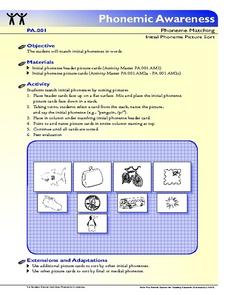Curated OER
How Big Is That Star?
Aspiring astronomers study stars. They compare stars and explain the relationship between radius, mass, and diameter. By creating a star simulation, they discover how a binary star system's orbit can cause changes in the observed...
Curated OER
The Sun
Middle schoolers draw diagram of sun and its layers, including photosphere, chromosphere, corona, convection and radiative zones, and core. Students then describe each layer in their own words, define sun spot cycle, and describe solar...
K5 Learning
Sun, Stars and Moon
Learners read about the objects we see in our night and day skies before answering five short answer comprehension questions.
Curated OER
Notes: Characteristics of Stars
Students investigate stars and the solar system by completing a worksheet. In this space science lesson, students complete a fill in the blank worksheet based on the stars and components of the cosmos.
Space Awareness
Know Your Planets
Does your class know their planets? Implement an activity that has them describing the solar system, identifying properties of the planets, and placing them in order from their distance from the sun.
Khan Academy
Challenge: Exploding Sun
Animating an object by moving it across a computer screen can be accomplished by drawing the object repetitively, each time adjusting some aspect of the drawing slightly. This activity is an easy introduction to animation in JavaScript,...
Curated OER
Hoe Long Does it Take to Get to a Star
Young scholars calculate the distance in light years. In this geometry lesson, students solve problems involving distance, using the distance formula. They rewrite big numbers using scientific notations and apply their knowledge of...
Curated OER
The Sun Affects Earth
Third graders read, write, and listen to information about the sun and its effects on the Earth.as it relates to its axis, orbit, rotate, and revolution. In this solar system lesson, 3rd graders examine how the sun...
Keep it Simple Science
The Earth in Space
Skim the surface of the earth with this brief, compact, summary of outer space. The sun, stars, galaxies, planets, and phases of the moon can be found in this all-in-one resource. Seventh graders will enjoy these simple worksheets to do...
Curated OER
Planets Curriculum
Learners complete an in-depth study of the known planets in the solar system. As a class, students identify the planets that are known in the universe, in the night sky. They explain the differences between planets and stars and the...
Star Date
Modeling the Night Sky
Dramatize the stars and planets as they become a visual representation of the solar system in this activity. Young astronomers track and simulate various constellations as they orbit the Earth to learn the position and motion of...
Can Teach
Groundhog Day Songs and Poems
This Groundhog Day add a bit of rhythm and rhyme with 23 songs and poems that put a spotlight on the holiday's shining star, the groundhog.
Khan Academy
Challenge: Parting Clouds
Let the sun shine as your young coders move the clouds across the sky while practicing animation coding skills in JavaScript. Younger learners may benefit from more guided help or a whole-class discussion before trying this coding...
Prestwick House
Romeo and Juliet
What is the setting of Romeo and Juliet? Who is the rich count who wants to marry Juliet? The 24 clues in a crossword puzzle test readers' knowledge of the events in Shakespeare's famous play of two young star-crossed lovers.
Core Knowledge Foundation
Astronomy Tell It Again!™ Read-Aloud Anthologys
A read-aloud anthology focuses on astronomy. Each week for three weeks, first graders are introduced to and listen to a text, answer comprehension questions, then complete extensions that include a learning activity and skills practice....
Core Knowledge Foundation
Third Grade Skills Unit 7: What’s in Our Universe?
Over four weeks, third graders participate in lessons that boost spelling, grammar, reading, and writing skills. Scholars explore spelling patterns, suffixes, singular and plural possessive nouns, quotations, and conjunctions....
Curated OER
What's the Main Idea??
Students determine how to form a simple topic sentence in order to summarize a reading passage to increase comprehension. They apply the strategy to reading a passage from a textbook by writing a topic sentence for paragraphs about the...
Curated OER
Planetary Orbits
Middle schoolers explore space science by completing a solar system identification worksheet. In this planets lesson, students discuss the different planets in our star system and identify their traits. Middle schoolers complete an...
Curated OER
Astrology: Fact or Fiction?
Students explore the topic of astrology and review the beliefs behind it. They read sample horoscopes. Using a portable digital planetarium, they view the night sky and the zodiac constellations. They examine and discuss the science...
K12 Reader
Absolute Location
Where in the world are we? As a reading comprehension exercise, kids read a short passage about navigation using latitude and longitude, and then respond to a series of questions based on the article.
Education World
Every Day Edit - Sousa Marches
For this everyday editing worksheet, learners correct grammatical mistakes in a short paragraph about John Philip Sousa. The errors range from punctuation, spelling, grammar, and capitalization.
K12 Reader
An Adverb Can Tell Where
Outside, backwards, far. Adverbs that tell where action is happening is the focus of a colorful one-page activity that asks kids to select the appropriate adverb from the provided word bank.
Curated OER
Observation and Inference
Assess your young scientists' understanding of the difference between observation and inference with this 20-question multiple choice quiz. It reviews a variety of physics and astronomy concepts, such as solar eclipses and sunspots, the...
Florida Center for Reading Research
Phonological Awareness: Phoneme Matching, Initial Phoneme Picture Sort
An activity focuses on phonemic awareness and initial letter sounds. Scholars sort picture cards by saying and matching the initial sounds each word makes.























